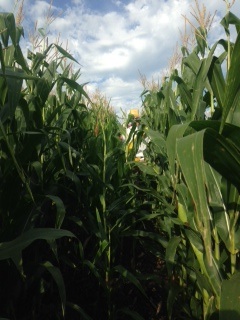|
|
On Tuesday we harvested 3 bags of heads from P1, 1 bag and 2 full egg cartons from P2

Today we trekked or “stalk whacked” through a corn field behind P1 to visit the site Kruzmarks

Where we found a sad looking Echinacea just peeking out from between blades of brome grass

where there was an interesting amalgamation of “ecosystems”… native prairie remnants, a pot hole, non-native conifer forest, and a monoculture of corn

Finally, we were able to finish out the day (Stuart’s last this season) at Staffenson. It was beautiful. White aster is blooming along with showy goldenrod and helianthus. Purple asters and gentians have maintained the purple hue as liatris is finishing blossoming.

This morning started with Jared and I doing an inventory of the Hesperostipa spartea (porcupine grass) in experimental plot 1. We are interested in determining the fitness of each H. spartea. We went to each plant found during a systematic search. We determined how many seeds were present on each culm of each plant. We counted the number of full (having a viable seed), inviable (having a seed that would not reproduce), or unknown (a glume that was empty, or peduncle that had no glume) seeds for each plant and harvested ripe seeds for later plantings. We found one studly plant that had 14 culms and 58 seeds that were ready to harvest! After experimenting with several methods of tying the immature awns together (to make sure we could find the seeds once they are mature and drop), we determined the most effective way to retain the seeds is to tie the awns together with twist ties. We hope the twist tie method allows us to harvest seeds before they disperse. We tried several other methods for tying the awns together (tying the awns to the stem, tying the awns to a red flag, and tying the awns together) but twist ties appear to work the best. In the afternoon I tagged my first Echinacea (plant 1980)!
For many of our experiments we want to harvest Echinacea heads when they are as ripe as possible, but before any achenes have dropped.
The standard harvest indicators are as follows:
- Phyllaries (involucral bracts) are brown
- Bracts that subtend each disc floret are brown and sharp
- Flower stalk (peduncle) is brown (not purple)
- 1st (uppermost) cauline lf is brown (note: 1st lf may be close to hd!)
Once harvest indicators 1 – 4 are positive, or if a head has loose achenes or is in some way deformed and you think achenes may be lost before the next harvest, harvest the hd! Make sure to look for loose achenes at the top of every hd with brown bracts.
Harvest a head by cutting it off and placing it carefully into a labeled bag. When cutting the hd off, hold the head firmly in one hand and cut the peduncle with the pruners 3-5 cm under the hd. You don’t need to open the bag all the way and the hd doesn’t need to go all the way to the bottom of the bag.
That’s our standard harvest protocol! Everything’s flowering so late this year, we won’t be harvesting for a while, but I wanted to post this while I was thinking about it.
Only about 13 heads left to harvest in the common garden experiment! I attached a pdf of listing all heads with no gbag info…
HarvestList2010FinalHarvest.pdf
Here’s a map of unharvested head locations in the main experiment (there’s one more head in the 99S garden).

Click to enlarge.
|
|






